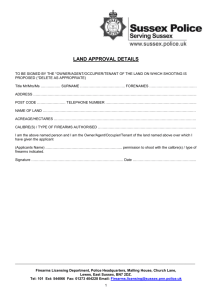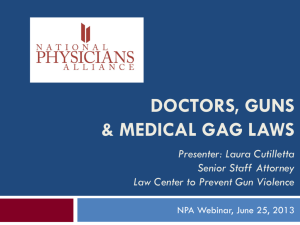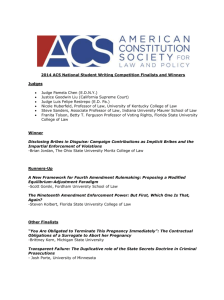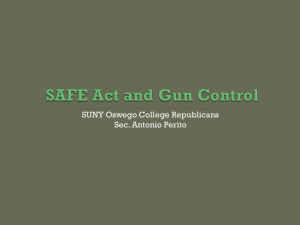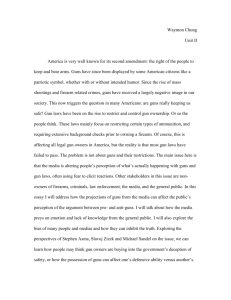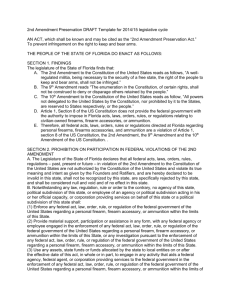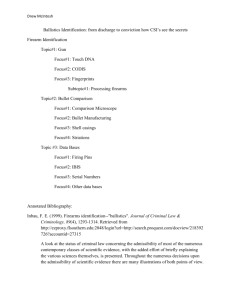111 - American Bar Association
advertisement
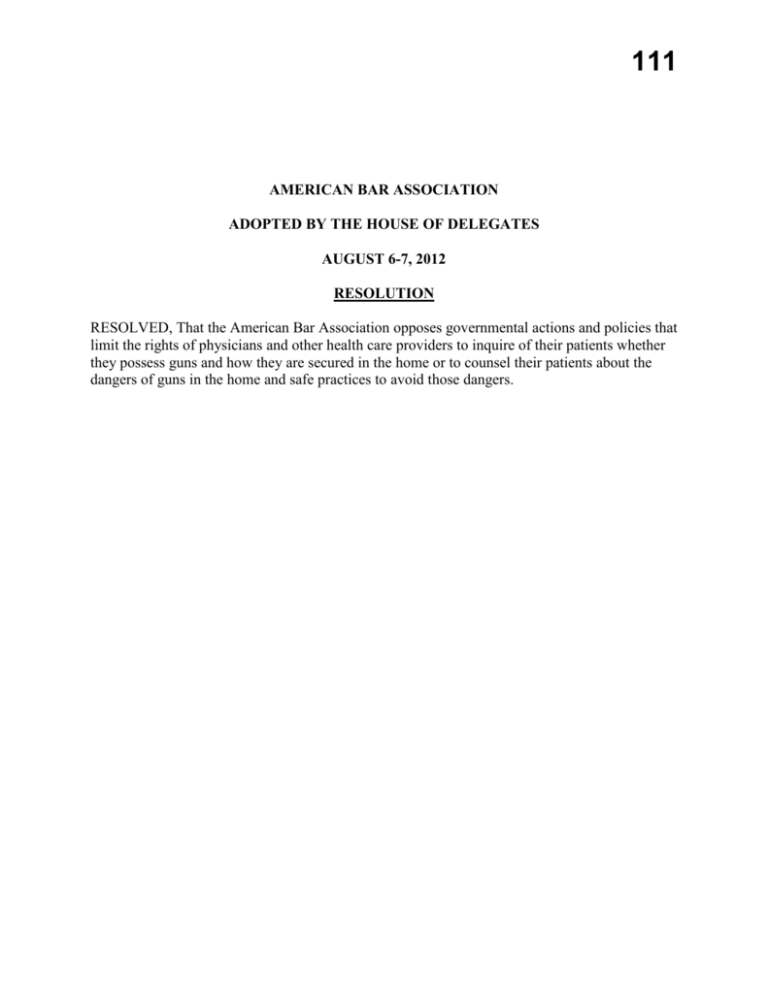
111 AMERICAN BAR ASSOCIATION ADOPTED BY THE HOUSE OF DELEGATES AUGUST 6-7, 2012 RESOLUTION RESOLVED, That the American Bar Association opposes governmental actions and policies that limit the rights of physicians and other health care providers to inquire of their patients whether they possess guns and how they are secured in the home or to counsel their patients about the dangers of guns in the home and safe practices to avoid those dangers. 111 REPORT Legislation that limits the right of physicians to ask questions of their patients about gun ownership and to counsel patients about the dangers of guns in the home (herein referred to as “physician gag rules”) interferes with the preventive care duties of health care practitioners and violates the First Amendment rights of physicians and their patients. Health care practitioners play a key role in counseling patients about the risks of injuries and best practices to minimize those risks as part of the practice of preventive care. Preventive care through safety counseling is a pillar of modern medicine, and is vitally important to the health and welfare of patients. It is also the ethical and legal responsibility of physicians. Failure to fulfill these duties results in a breach of the objective standard of care owed to patients. For medical practitioners to meet their preventive care and safety counseling responsibilities, they must be able to discuss a broad range of topics with their patients related to known risk factors. This unfettered access allows doctors to adequately assess and address these factors with their patients. Risk factors that may be discussed vary depending on the age of the patient, but for adults often include alcohol consumption, illicit drug use, smoking, diet, and exercise; pediatricians often discuss wearing seat belts and bicycle helmets, the potential dangers of backyard swimming pools, and the need to securely store household cleaners and toxins.1 Firearms in the home are another known risk factor that doctors may choose to discuss with their patients or the parents of young patients. These discussions may focus on the known dangers of keeping guns in the home and the importance of keeping firearms unloaded and stored separately from ammunition to mitigate some of these risks. Safety counseling of this type is recommended by professional medical associations.2 If legislation is passed that inhibits a doctor’s ability to discuss such vitally important risk factors with their patients, there are direct First Amendment implications for both health care practitioners and patients, as well as professional constraints on a physician’s ability to meet the objective standard of care owed to their patients. These are some of the consequences that resulted from Florida’s physician gag rule, which was in place from June 2011 until an injunction stopped enforcement of the law in September 2011, and are likely consequences should other states enact similar gag rules. I. Importance of Safety Counseling A crucial element of practicing medicine is the prevention of intentional and unintentional physical injuries. An important tool to achieve this goal is safety counseling. This requires an open dialogue between doctor and patient about all known risk factors, including firearms in the home. As such, many physicians counsel patients about the dangers of guns in the home and the importance of storing firearms unloaded and separately from ammunition. 1 See Wollschlaeger et al. v. Scott et al., No. 11-22026-Civ, U.S. District Court for the Southern District of Florida, First Amended Complaint for Declaratory and Injunctive Relief at 24, 32, June 24, 2011. 2 See, e.g., American Medical Association, Prevention of Firearm Accidents in Children, Policy H-145.990, Res. 165, I-89 & American Psychiatric Association, Position Statement No. 200107. 1 111 This is important because one-third of U.S. homes with children younger than eighteen have a firearm, and more than 40% of gun-owning households with children store their guns unlocked, with one-quarter of those homes storing them loaded.3 Unintentional injury is a health hazard, and is the leading cause of death among children older than one year, adolescents, and young adults.4 This includes injuries from accidents involving firearms. According to the most recent data sets published by the Centers for Disease Control and Prevention, every day in America, thirty-eight children and teens are injured by firearms and eight are killed by firearms.5 Intentional injury is also a major health hazard, with suicide being a particular risk about which physicians counsel patients. Suicide is the third leading cause of death among individuals aged 15 to 24 and is the second leading cause of death for individuals aged 25 to 34.6 Firearms are frequently used in suicide and suicide attempts, and suicide attempts committed with firearms are fatal more than 90% of the time. Use of a firearm is the most common method of suicide among adult men – 55.7%.7 Intentional and unintentional injury related deaths caused by firearms claim more lives than all injury sources except motor vehicles.8 Because of the dangers firearms pose, safety counseling, which has the potential to reduce injury and save lives, is recommended by professional medical associations. It is also shown to have concrete results. One study showed that after a single instance of verbal counseling, more than 58% of patients reported making changes to their gun storage habits.9 The American Academy of Pediatrics recommends that parents of pre-school aged children remove handguns from places where children live and play. They advise parents of adolescents that firearms in the home are particularly dangerous for this age group because of their propensity for impulsive, unplanned use resulting in suicide, homicide, or serious 3 Renee Johnson, M.P.H. et al., Firearm Ownership and Storage Practices, U.S. Households, 1992-2002, 27 AM. J. PREVENTIVE MED. 173, 179 (2004). See also Teresa L. Albright, M.D. & Sandra K. Burge, Ph.D., Improving Firearm Storage Habits: Impact of Brief Office Counseling by Family Physicians, 16 J. AM. BOARD FAMILY PRACTICE 1, 40 (Jan.-Feb. 2003). 4 Centers for Disease Control and Prevention, 10 Leading Causes of Death by Age Group (Sept. 3, 2010) available at: hppt://www.cdc.gov/injury/wisqars/images/Death_by_Age_2007.gtf. 5 Centers for Disease Control and Prevention, WISQARS Nonfatal Injury Reports, available at: http://webappa.cdc.gov/sasweb/ncipc/nfirates2001.html; WISQARS Injury Mortality Reports, 1999-2007, available at: http://webappa.cdc.gov/sasweb/ncipc/mortrate10_sy.html. 6 Centers for Disease Control and Prevention, Suicide: Facts at a Glance (Summer 2010), available at: http://www.cdc.gov/violenceprevention/pdf/Suicide_DataSheet-a.pdf. 7 Centers for Disease Control and Prevention, Suicide: Facts at a Glance (Summer 2010), available at: http://www.cdc.gov/violenceprevention/pdf/Suicide_DataSheet-a.pdf. 8 Teresa L. Albright, M.D. & Sandra K. Burge, Ph.D., Improving Firearm Storage Habits: Impact of Brief Office Counseling by Family Physicians, 16 J. AM. BOARD FAMILY PRACTICE 1, 40 (Jan.-Feb. 2003). 9 Teresa L. Albright, M.D. & Sandra K. Burge, Ph.D., Improving Firearm Storage Habits: Impact of Brief Office Counseling by Family Physicians, 16 J. AM. BOARD FAMILY PRACTICE 1, 44 (Jan.-Feb. 2003). 2 111 unintentional injuries. If parents choose to keep a firearm in the home, however, they are advised to store it unloaded and separately from ammunition in locked cabinets. The American Medical Association adopted a policy to reduce pediatric firearm morbidity and mortality by encouraging its members to: (a) inquire as to the presence of household firearms as part of childproofing the home; (b) educate patients to the dangers of firearms to children; (c) encourage patients to educate their children and neighbors as to the dangers of firearms; and (d) routinely remind patients to obtain firearm safety locks, to store firearms under lock and key, and to store ammunition separately from firearms.10 Safety counseling regarding firearms in the home is also a recommended part of adult medical care. The American Psychiatric Association has recommended that “health professionals and health systems should ask about firearm ownership whenever clinically appropriate in the judgment of the physician.”11 II. Florida’s Physician Gag Rule – H.B. 155 Despite the importance of discussing potential risks related to firearms in the home with patients, on June 2, 2011, Governor Rick Scott signed an unprecedented new law in Florida that interfered with health care practitioners' ability to warn patients about the risks posed by firearms and to offer them advice on gun safety. The Florida law, H.B. 155, subjected health care practitioners to possible sanctions, including fines and loss of their license, if they discussed or recorded information in a patient's chart about firearm safety that a medical board later determined was not "relevant" or was "unnecessarily harassing." The law, however, did not define these terms. According to the State of Florida’s legislative findings, as summarized by U.S. District Judge Marcia G. Cooke of the U.S. District Court for the Southern District of Florida, the state passed H.B. 155 in reaction to an incident in Ocala, Florida where a physician advised the mother of a minor patient that she had thirty days to find a new pediatrician after she refused to answer questions about firearms in her home.12 The House of Representatives’ Staff Analysis notes that “Florida law does not contain any provision that prohibits physicians or other medical staff from asking a patient whether he or she owns a firearm or whether there is a firearm in the patient’s home.”13 The court presumed that H.B. 155 was a means to rectify this perceived gap in Florida law.14 Judge Cooke also stated that the legislative debates on the bill revealed that the Florida legislature relied heavily on anecdotal information about physicians asking patients about 10 American Medical Association, Prevention of Firearm Accidents in Children, Policy H-145.990, Res. 165, I-89. 11 American Psychiatric Association, Position Statement No. 200107. 12 See Wollschlaeger et al. v. Farmer et al., No. 11-22026-Civ, U.S. District Court for the Southern District of Florida, Order Granting Plaintiffs’ Motion for Preliminary Injunction at 2, Sept. 14, 2011. 13 Fla. H.R. 0155C, at 2; Fla. H.R. 0155E, at 2. 14 See Wollschlaeger et al., v. Farmer et al., No. 11-22026-Civ, U.S. District Court for the Southern District of Florida, Order Granting Plaintiffs’ Motion for Preliminary Injunction at 2, Sept. 14, 2011. 3 111 firearm ownership, physicians misrepresenting that Medicaid would not pay out claims if the patient did not answer questions regarding firearms, or physicians refusing to conduct examinations on patients who refused to answer questions about firearm ownership.15 Judge Cooke went on to state that it did not appear that the Florida legislature relied on any studies, research, or statistics on physicians’ practices or patients’ experiences on this issue.16 III. Litigation Over Florida’s Physician Gag Rule On June 6, 2011, a lawsuit was filed to strike down and prevent enforcement of H.B. 155. The suit was filed in federal district court in Florida on behalf of the American Academy of Pediatrics, Florida Chapter; American Academy of Family Physicians, Florida Chapter; the American College of Physicians, Florida Chapter; and other individual physicians. The suit charged that H.B. 155 is unconstitutionally vague and violates the First Amendment to the U.S. Constitution by having a severe chilling effect on confidential, life-saving discussions about the dangers of firearms in the home. The suit sought a permanent injunction to block implementation of the law. The lawsuit cited the extreme risk posed by firearms and the duty of health care providers to counsel patients about risks to their health and well-being. One-third of U.S. homes with children younger than 18 have a firearm.17 Children aged 5 to 14 years in the United States are 11 times more likely to be killed accidentally with a gun than similarly aged children in other developed countries.18 Because of these well-documented risks, pediatricians advise parents to keep guns away from children, secured with gun locks, and stored separately from ammunition. On September 14, 2011, U.S. District Judge Marcia G. Cooke of the U.S. District Court for the Southern District of Florida granted a preliminary injunction against enforcement of H.B. 155, holding that plaintiffs would likely prevail in their facial challenge on grounds that the law was an unconstitutional content-based restriction on speech that specifically targeted firearms issues. Rejecting the State of Florida’s argument, Judge Cooke held that the law “does not implicate rights that the Second Amendment protects.”19 Judge Cooke also stated that “the law curtails practitioners’ ability to inquire about whether patients own firearms and burdens their ability to deliver a firearm safety message to patients under certain circumstances. The…Act thus implicates practitioners’ First Amendment 15 See Wollschlaeger et al., v. Farmer et al. No. 11-22026-Civ, U.S. District Court for the Southern District of Florida, Order Granting Plaintiffs’ Motion for Preliminary Injunction at 2, Sept. 14, 2011. 16 See Wollschlaeger et al., v. Farmer et al. No. 11-22026-Civ, U.S. District Court for the Southern District of Florida, Order Granting Plaintiffs’ Motion for Preliminary Injunction at 2, Sept. 14, 2011. 17 Renee M. Johnson et al., Firearm Ownership and Storage Practices, U.S. Households, 1992-2002, 27 AM. J. PREVENTIVE MED. 173, 179 (2004). 18 Erin G. Richardson & David Hemenway, Homicide, Suicide, and Unintentional Firearm Fatality: Comparing the United States With Other High-Income Countries, 2003, J. TRAUMA, INJURY, INFECTION, & CRITICAL CARE at 1 2010. 19 Wollschlaeger et al., v. Farmer et al., No. 11-22026-Civ, U.S. District Court for the Southern District of Florida, Order Granting Plaintiffs’ Motion for Preliminary Injunction at 7, Sept. 14, 2011. 4 111 rights of free speech. The Act also implicates patients’ freedom to receive information about firearm safety, which the First Amendment protects.”20 The Brady Center to Prevent Gun Violence represents plaintiffs as well as the law firms of Ropes and Gray, Astigarraga Davis Mullins & Grossman, and Weisberg and Kainen. IV. First Amendment Implications Regarding Physician Gag Rules Health care practitioners have rights under the First Amendment of the U.S. Constitution to engage in open and free exchanges of information and advice with their patients, including about ways to reduce the risks posed by firearms. Gag rules seek to chill this speech and punish health care practitioners for asking questions of, and providing information to, their patients about firearm safety. The First Amendment does not permit such content-based intrusions on speech. Gag rules also deprive patients of their First Amendment right to receive potentially lifesaving information regarding safety measures they can take to protect themselves and their families from injury or death. The practice of medicine requires a free and open exchange of questions, answers, and information between patients and their health care practitioners. For that reason, both state and federal law protect the confidentiality of such conversations. Practitioners must engage in highly personal exchanges with their patients about private, confidential topics, so patients understand the risks to themselves, their families, and their children arising from decisions they make and conduct they engage in. Gag rules directly interfere with, and intrude upon, health care practitioners’ ability to engage fully in these consultations by severely restricting inquiries about a significant and preventable risk to patients. The First Amendment does not permit individual states to require health care practitioners to conform their communications with their patients to the state’s preferences. By restricting the free and open exchange of information between a physician and patient in this manner, gag rules violate the First and Fourteenth Amendments to the U.S. Constitution. V. Second Amendment Implications Regarding Physician Gag Rules In District of Columbia v. Heller, the Supreme Court ruled, in a 5-4 decision, that the Second Amendment to the U.S. Constitution guarantees a limited right to possess handguns in the home for self-defense.21 Two years later, in McDonald v. City of Chicago, the Court, by the same 5-4 majority, held this right applicable to state and local laws through the Due Process Clause of the Fourteenth Amendment.22 This Second Amendment right to possess handguns for self-defense, however, is not implicated by physicians who counsel their patients about the dangers of guns in the home. As Judge Cooke stated, “A practitioner who counsels a patient on firearm safety, even when entirely irrelevant to medical care or safety, does not affect nor interfere with the patient’s right to 20 Wollschlaeger et al., v. Farmer et al., No. 11-22026-Civ, U.S. District Court for the Southern District of Florida, Order Granting Plaintiffs’ Motion for Preliminary Injunction at 5, Sept. 14, 2011. 21 554 U.S. 570, 635 (2008). 22 130 S.Ct. 3020, 3047 (2010). 5 111 continue to own, possess, or use firearms.”23 In this context, it is worth noting that the Heller majority itself made it clear that its analysis of the right does not “suggest the invalidity of laws regulating the storage of firearms to prevent accidents.” This language indicates that even laws requiring that patients follow the advice of their physicians about safe storage of firearms would not violate the Second Amendment. The provision of safety counseling by physicians, who are private, not governmental actors, to patients who are entirely free to ignore the physicians’ advice, raises no serious Second Amendment issue. Nor should state gag rule legislation be viewed as necessary to vindicate the right recognized in Heller and McDonald. For these reasons, the ABA opposes physician gag rule legislation. Respectfully submitted, The Honorable William D. Missouri Chair, ABA Standing Committee on Gun Violence August 2012 23 Wollschlaeger et al., v. Farmer et al., No. 11-22026-Civ, U.S. District Court for the Southern District of Florida, Order Granting Plaintiffs’ Motion for Preliminary Injunction at 6-7, Sept. 14, 2011. 6 111 GENERAL INFORMATION FORM Submitting Entity: Standing Committee on Gun Violence Submitted By: Hon. William D. Missouri 1. Summary of Resolution(s). The resolution opposes governmental actions and policies that would limit the rights of physicians to inquire of their patients whether they possess guns and how they are secured in the home or that limit the rights of physicians to counsel their patients about the dangers of guns in the home and safe practices to avoid those dangers. 2. Approval by Submitting Entity. Standing Committee on Gun Violence approved this resolution on March 15, by conference call. 3. Has this or a similar resolution been submitted to the House or Board previously? No 4. What existing Association policies are relevant to this Resolution and how would they be affected by its adoption? This resolution is consistent with the ABA’s historic position of treating gun violence as a pubic health measure, see, e.g., support of legislation to encourage gun safety education (1991) and call for comprehensive approach to addressing gun violence by young persons in school (1998). The resolution is also consistent with prior resolutions on related topics, specifically a policy adopted by the House of Delegates in 2005 (MY) which opposed governmental actions and policies that interfere with patients’ abilities to receive from their healthcare providers, including healthcare professionals and entities, in a timely manner: (a) all of the relevant and medically accurate information necessary for fully informed healthcare decision making; and (b) information with respect to their access to medically appropriate care, as defined by the applicable medical standard of care. Finally, the resolution is consistent with and complimentary to existing Association policy regarding gun violence and federal and state firearms laws. Since 1965, the ABA House of Delegates has considered and approved over a dozen policy recommendations aimed at preventing gun violence, including those to ban assault weapons, prohibit firearm possession by domestic abusers, regulate guns as consumer products and limit gun sales to minors. 7 111 5. What urgency exists which requires action at this meeting of the House? While there is no urgency, a federal court action is currently pending regarding a Florida statute that would restrict physician’s from inquiring of patients about the presence of guns in the household. 6. Status of Legislation. (If applicable) Not applicable. 7. Brief explanation regarding plans for implementation of the policy, if adopted by the House of Delegates. This is primarily a state matter and the Standing Committee on Gun Violence will make this information known to state legislative bodies that may contemplate, following Florida’s lead, to enact related legislation. The Committee is already planning to conduct a CLE program at the 2012 annual meeting on this topic, and will likely disseminate educational material on this matter at later date. 8. Cost to the Association. (Both direct and indirect costs) There are no direct or indirect costs to the Association anticipated as a result of its adoption of the Resolution as ABA policy. 9. Disclosure of Interest. (If applicable) Committee member Dennis Henigan is an attorney with the Brady Center to Prevent Gun Violence. The Center is representing the petitioners in the federal action challenging the Florida statute that restricts health care practitioners from discussing the presence and maintenance of guns in the home. Please note that the decision by the Committee to submit this Resolution was unanimous. 10. Referrals. The Standing Committee on Medical Professional Liability and the Commission on Domestic and Sexual Violence have agreed to cosponsor this Resolution. It will also be referred to Tort Trial and Insurance Practice, Family Law, Individual Rights and Responsibilities, Litigation, Criminal Justice Section, Health Law, and Commission on Youth at Risk. 8 111 11. Contact Name and Address Information. (Prior to the meeting. Please include name, address, telephone number and e-mail address) Hon. William D. Missouri, Chair, Standing Committee on Gun Violence Circuit Court 7th Judicial Circuit PO Box 422 Upper Marlboro, MD 20773 301-952-3623 wmissouri@co.pg.md.us Jin Kim, Staff Liaision ABA, 740 15th Street NW Washington, DC 20005 202-662-1505 Jin.kim@americanbar.org 12. Contact Name and Address Information. (Who will present the report to the House? Please include name, address, telephone number, cell phone number and e-mail address.) Hon. William D. Missouri, Chair, Standing Committee on Gun Violence Circuit Court 7th Judicial Circuit PO Box 422 Upper Marlboro, MD 20773 301-952-3623 wmissouri@co.pg.md.us 9 111 EXECUTIVE SUMMARY 1. Summary of the Resolution The resolution opposes governmental actions and policies that would limit the rights of physicians to inquire of their patients whether they possess guns and how they are secured in the home or that limit the rights of physicians to counsel their patients about the dangers of guns in the home and safe practices to mitigate those dangers. 2. Summary of the Issue that the Resolution Addresses Florida recently enacted a statute that prohibits physicians practicing in that state from inquiring or seeking information from patients regarding the presence of guns in the home. The Act is currently under challenge in court action, but introduction of similar legislation in other states is very likely. The resolution supported by its background report articulates legal and policy reasons to oppose enactment of similar legislation or establish such policies by administrative action. Physician’s inquiries of their patients about firearms are generally routine and part of standard recommended medical protocols. For medical practitioners to meet their preventive care and safety counseling responsibilities, they must be able to discuss a broad range of topics with their patients related to known risk factors. This unfettered access allows doctors to adequately assess and address these factors with their patients. Risk factors that may be discussed vary depending on the age of the patient, but for adults often include alcohol consumption, illicit drug use, smoking, diet, and exercise; pediatricians often discuss wearing seat belts and bicycle helmets, the potential dangers of backyard swimming pools, and the need to securely store household cleaners and toxins. Firearms in the home are another known risk factor that doctors may choose to discuss with their patients or the parents of young patients. These discussions may focus on the known dangers of keeping guns in the home and the importance of keeping firearms unloaded and stored separately from ammunition to mitigate some of these risks. The practice of medicine requires a free and open exchange of questions, answers, and information between patients and their health care practitioners. For that reason, both state and federal law protect the confidentiality of such conversations. Practitioners must engage in highly personal exchanges with their patients about private, confidential topics, so patients understand the risks to themselves, their families, and their children arising from decisions they make and conduct they engage in. Gag rules directly interfere with, and intrude upon, health care practitioners’ ability to engage fully in these consultations by severely restricting inquiries about a significant and preventable risk to patients. The First Amendment does not permit individual states to require health care practitioners to conform their communications with their patients to the state’s preferences. The ABA has historically opposed legislation to establish a similar “gag rule” to prevent physicians to inquire or discuss abortion issues with patients and this resolution calls for opposition on a similar basis to efforts to ban physician discussion or inquiry regarding safe practices related to firearms. By restricting the free and open exchange of information between a physician and patient in this manner, gag rules violate the First and Fourteenth Amendments to the U.S. Constitution. 10 111 3. Please Explain How the Proposed Policy Position will address the issue The proposed policy would put the Association on record in support of the principles underlying the accepted practice in the great majority of states and in opposition to recent efforts to enact legislation to restrict physical discussion with patients of safety practices and risks of firearms in the home. 4. Summary of Minority Views None. 11
